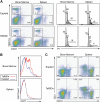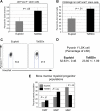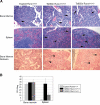Highly penetrant myeloproliferative disease in the Ts65Dn mouse model of Down syndrome
- PMID: 17901249
- PMCID: PMC2200841
- DOI: 10.1182/blood-2007-04-085670
Highly penetrant myeloproliferative disease in the Ts65Dn mouse model of Down syndrome
Abstract
Children with Down syndrome (DS) display macrocytosis, thrombocytosis, and a 500-fold increased risk of developing megakaryocytic leukemia; however, the specific effects of trisomy 21 on hematopoiesis remain poorly defined. To study this question, we analyzed blood cell development in the Ts65Dn mouse model of DS. Ts65Dn mice are trisomic for 104 orthologs of Hsa21 genes and are the most widely used mouse model for DS. We discovered that Ts65Dn mice display persistent macrocytosis and develop a myeloproliferative disease (MPD) characterized by profound thrombocytosis, megakaryocyte hyperplasia, dysplastic megakaryocyte morphology, and myelofibrosis. In addition, these animals bear distorted hematopoietic stem and myeloid progenitor cell compartments compared with euploid control littermates. Of the 104 trisomic genes in Ts65Dn mice, Aml1/Runx1 attracts considerable attention as a candidate oncogene in DS-acute megakaryoblastic leukemia (DS-AMKL). To determine whether trisomy for Aml1/Runx1 is essential for MPD, we restored disomy at the Aml1/Runx1 locus in the Ts65Dn strain. Surprisingly, trisomy for Aml1/Runx1 is not required for megakaryocyte hyperplasia and myelofibrosis, suggesting that trisomy for one or more of the remaining genes can promote this disease. Our studies demonstrate the potential of DS mouse models to improve our understanding of chromosome 21 gene dosage effects in human hematologic malignancies.
Figures



 indicate euploid controls;
indicate euploid controls;  indicate Ts65Dn. BFU-E indicates erythroid burst-forming unit; CFU-GM, granulocyte-macrophage colony-forming unit; and CFU-MK, megakaryocyte colony-forming unit. n = 3 Ts65Dn; n = 3 euploid littermates. Differences in spleen colony number are P = .1 for CFU-MKs, P = .24 for CFU-GMs, and P = .6 for BFU-Es. Error bars represent SE.
indicate Ts65Dn. BFU-E indicates erythroid burst-forming unit; CFU-GM, granulocyte-macrophage colony-forming unit; and CFU-MK, megakaryocyte colony-forming unit. n = 3 Ts65Dn; n = 3 euploid littermates. Differences in spleen colony number are P = .1 for CFU-MKs, P = .24 for CFU-GMs, and P = .6 for BFU-Es. Error bars represent SE.

 represent euploid controls;
represent euploid controls;  represent Ts65Dn. n = 9 Ts65Dn; n = 9 controls. Error bars represent SE.
represent Ts65Dn. n = 9 Ts65Dn; n = 9 controls. Error bars represent SE.
Similar articles
-
Mouse models of Down syndrome: gene content and consequences.Mamm Genome. 2016 Dec;27(11-12):538-555. doi: 10.1007/s00335-016-9661-8. Epub 2016 Aug 18. Mamm Genome. 2016. PMID: 27538963 Free PMC article. Review.
-
Trisomy of Erg is required for myeloproliferation in a mouse model of Down syndrome.Blood. 2010 May 13;115(19):3966-9. doi: 10.1182/blood-2009-09-242107. Epub 2009 Dec 9. Blood. 2010. PMID: 20007548
-
Early lineage priming by trisomy of Erg leads to myeloproliferation in a Down syndrome model.PLoS Genet. 2015 May 14;11(5):e1005211. doi: 10.1371/journal.pgen.1005211. eCollection 2015 May. PLoS Genet. 2015. PMID: 25973911 Free PMC article.
-
Increased dosage of the chromosome 21 ortholog Dyrk1a promotes megakaryoblastic leukemia in a murine model of Down syndrome.J Clin Invest. 2012 Mar;122(3):948-62. doi: 10.1172/JCI60455. Epub 2012 Feb 22. J Clin Invest. 2012. PMID: 22354171 Free PMC article.
-
Developmental instability of the cerebellum and its relevance to Down syndrome.J Neural Transm Suppl. 2001;(61):11-34. doi: 10.1007/978-3-7091-6262-0_2. J Neural Transm Suppl. 2001. PMID: 11771737 Review.
Cited by
-
Breathing and Oxygen Carrying Capacity in Ts65Dn and Down Syndrome.Function (Oxf). 2023 Oct 6;4(6):zqad058. doi: 10.1093/function/zqad058. eCollection 2023. Function (Oxf). 2023. PMID: 37954975 Free PMC article.
-
Myeloid Proliferations Associated with Down Syndrome.J Hematop. 2015 Sep;8(3):169-176. doi: 10.1007/s12308-014-0225-0. Epub 2014 Dec 14. J Hematop. 2015. PMID: 26753010 Free PMC article. No abstract available.
-
Proteomic analysis of six- and twelve-month hippocampus and cerebellum in a murine Down syndrome model.Neurobiol Aging. 2018 Mar;63:96-109. doi: 10.1016/j.neurobiolaging.2017.11.010. Epub 2017 Nov 26. Neurobiol Aging. 2018. PMID: 29245059 Free PMC article.
-
Down syndrome and the molecular pathogenesis resulting from trisomy of human chromosome 21.J Biomed Res. 2010 Mar;24(2):87-99. doi: 10.1016/S1674-8301(10)60016-4. J Biomed Res. 2010. PMID: 23554618 Free PMC article.
-
Altered hematopoiesis in trisomy 21 as revealed through in vitro differentiation of isogenic human pluripotent cells.Proc Natl Acad Sci U S A. 2012 Oct 23;109(43):17567-72. doi: 10.1073/pnas.1215468109. Epub 2012 Oct 8. Proc Natl Acad Sci U S A. 2012. PMID: 23045682 Free PMC article.
References
-
- Roizen NJ, Amarose AP. Hematologic abnormalities in children with Down syndrome. Am J Med Genet. 1993;46:510–512. - PubMed
-
- Kivivuori SM, Rajantie J, Siimes MA. Peripheral blood cell counts in infants with Down's syndrome. Clin Genet. 1996;49:15–19. - PubMed
-
- Gurbuxani S, Vyas P, Crispino JD. Recent insights into the mechanisms of myeloid leukemogenesis in Down syndrome. Blood. 2004;103:399–406. - PubMed
-
- Groet J, McElwaine S, Spinelli M, et al. Acquired mutations in GATA1 in neonates with Down's syndrome with transient myeloid disorder. Lancet. 2003;361:1617–1620. - PubMed
-
- Mundschau G, Gurbuxani S, Gamis AS, Greene ME, Arceci RJ, Crispino JD. Mutagenesis of GATA1 is an initiating event in Down syndrome leukemogenesis. Blood. 2003;101:4298–4300. - PubMed
Publication types
MeSH terms
Substances
Grants and funding
LinkOut - more resources
Full Text Sources
Medical
Molecular Biology Databases

